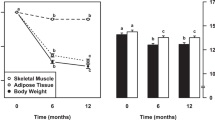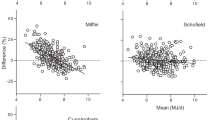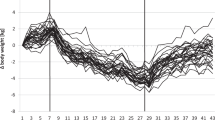Abstract
OBJECTIVE: The objective of this study was to determine whether there are independent effects of extracellular fluid volume (ECF) and fat mass (FM) on resting energy expenditure (REE) relative to fat-free mass (FFM) in adult men and women.
METHODS: Multiple linear regression analysis was used to relate REE, as determined by indirect calorimetry, to FFM and FM (measured using dual energy X-ray absorptiometry) and ECF (measured using bromide space and/or the radiosulfate washout space) in 153 women and 100 men with varying amounts of body fat.
RESULTS: REE correlated significantly with FFM and FM in women (r=0.65 and r=0.63, both P<0.001) and men (r=0.62 and r=0.48, both P<0.001, FFM and FM, respectively). In a multiple linear regression analysis FFM, FM and age significantly contributed to the ability to predict REE in both genders. The models that were derived were not significantly different between women and men. In women the contribution to REE from FM was easier to detect when FM was greater. Adjustment of FFM for ECF did not improve the relationship between FFM and REE.
CONCLUSIONS: FFM, FM and age are significant, independent predictors of REE in both men and women. Adjustment of FFM for ECF does not improve the ability of FFM to predict REE, which suggests that ECF is a highly integrated component of FFM in healthy adults. Expressing REE relative to FFM alone will introduce errors when lean and obese populations are compared.
This is a preview of subscription content, access via your institution
Access options
Subscribe to this journal
Receive 12 print issues and online access
$259.00 per year
only $21.58 per issue
Buy this article
- Purchase on Springer Link
- Instant access to full article PDF
Prices may be subject to local taxes which are calculated during checkout



Similar content being viewed by others
References
Cunningham JJ . Body composition as a determinant of energy expenditure: a synthetic review and a proposed general prediction equation Am J Clin Nutr 1991 54: 963–969.
Mifflin MD, St Jeor ST, Hill LA, Scott BJ, Daugherty SA, Koh YO . A new predictive equation for resting energy expenditure in healthy individuals Am J Clin Nutr 1990 51: 241–247.
Nelson KM, Weinsier RL, Long CL, Schutz Y . Prediction of resting energy expenditure from fat-free mass and fat mass Am J Clin Nutr 1992 56: 848–856.
Ferraro R and Ravussin E . Fat mass in predicting resting metabolic rate Am J Clin Nutr 1992 56: 460–461.
Simonsen L, Bulow J, Madsen J . Adipose tissue metabolism in humans determined by vein catheterization and microdialysis techniques Am J Physiol 1994 266: E357–365.
Brundin T, Branstrom R, Wahren J . Effects of oral vs i.v. glucose administration on splanchnic and extrasplanchnic O2 uptake and blood flow Am J Physiol 1996 271: E496–E504.
Brundin T, Thorne A, Wahren J . Heat leakage across the abdominal wall and meal-induced thermogenesis in normal-weight and obese subjects Metabolism 1992 41: 49–55.
Jensen MD, Johnson CM, Cryer PE, Murray MJ . Thermogenesis after a mixed meal: role of leg and splanchnic tissues in men and women Am J Physiol 1995 268: E433–438.
Bogardus C, Lillioja S, Ravussin E . Familial dependence of the resting metabolic rate New Engl J Med 1986 315: 96–100.
Ferrannini E . The theoretical bases of indirect calorimetry: a review Metabolism 1988 37: 287–301.
Jensen MD, Kanaley JA, Roust LR . Assessment of body composition with use of dual-energy X-ray absorptiometry: evaluation and comparison with other methods Mayo Clin Proc 1993 68: 867–873.
Wong WW, Sheng HP, Morkeberg JC, Kosanovich JL, Clarke LL, Klein PD . Measurement of extracellular water volume by bromide ion chromatography Am J Clin Nutr 1989 50: 1290–1294.
Pierson RN, Wang J, Colt EW, Neumann P . Body composition measurements in normal man: the potassium, sodium, sulfate and tritium spaces in 58 adults J Chron Dis 1982 35: 419–428.
Ravussin E, Lillioja S, Knowler WC . Reduced rate of energy expenditure as a risk factor for body-weight gain New Engl J Med 1988 318: 467–472.
Omvik P, Tarazi RC, Bravo EL . Determination of extracellular fluid volume in uremic patients by oral administration of radiosulfate Kidney Int 1979 15: 71–79.
Ryan RJ, Pascal LR, Inoye T, Bernstein L . Experiences with radiosulfate in the estimation of physiologic extracellular water in healthy and abnormal man J Clin Invest 1956 35: 1119–1130.
Bauer JH, Willis LR, Burt RW, Grim CE . Volume studies. II. Simultaneous determination of plasma volume, red cell mass, extracellular fluid, and total body water before and after volume expansion in dog and man J Lab Clin Med 1975 86: 1009–1017.
Walser M, Seldin DW, Grollmann A . An evaluation of radiosulfate for the determination of the volume of extracellular fluid in man and dogs J Clin Invest 1953 32: 299–311.
Garrow JS and Webster J . Are pre-obese people energy thrifty? Lancet 1985 1: 670–671.
Bernstein RS, Thornton JC, Yang MU . Prediction of the resting metabolic rate in obese patients Am J Clin Nutr 1983 37: 595–602.
Dionne I, Despres JP, Bouchard C, Tremblay A . Gender difference in the effect of body composition on energy metabolism Int J Obes Relat Metab Disord 1999 23: 312–319.
Cunningham JJ . A reanalysis of the factors influencing basal metabolic rate in normal adults Am J Clin Nutr 1980 33: 2372–2374.
Ravussin E, Lillioja S, Anderson TE, Christin L, Bogardus C . Determinants of 24-hour energy expenditure in man. Methods and results using a respiratory chamber J Clin Invest 1986 78: 1568–1578.
Roubenoff R, Kehayias JJ, Dawson-Hughes B, Heymsfield SB . Use of dual-energy X-ray absorptiometry in body composition studies: not yet a ‘gold standard’ Am J Clin Nutr 1993 58: 589–591.
Heshka S, Yang M, Wang J, Burt P, Pi-Sunyer FX . Weight loss and change in resting metabolic rate Am J Clin Nutr 1990 52: 981–986.
Ferraro R, Lillioja S, Fontvieille A, Rising R, Bogardus C, Ravussin E . Lower sedentary metabolic rate in women compared with men J Clin Invest 1992 90: 780–784.
Weststrate JA, Dekker J, Stoel M, Begheijn L, Deurenberg P, Hautvast JGAJ . Resting energy expenditure in women: impact of obesity and body-fat distribution Metabolism 1990 39: 11–17.
Acknowledgements
We wish to thank Rita Nelson, Carol Siverling and the staff of the Mayo GCRC for excellent technical assistance. Supported by grants DK45353, DK40484 and RR00585 from the US Public Health Service, the Minnesota Obesity Center (DK50456) and the Mayo Foundation.
Author information
Authors and Affiliations
Corresponding author
Rights and permissions
About this article
Cite this article
Nielsen, S., Hensrud, D., Romanski, S. et al. Body composition and resting energy expenditure in humans: role of fat, fat-free mass and extracellular fluid. Int J Obes 24, 1153–1157 (2000). https://doi.org/10.1038/sj.ijo.0801317
Received:
Revised:
Accepted:
Published:
Issue Date:
DOI: https://doi.org/10.1038/sj.ijo.0801317
Keywords
This article is cited by
-
Validation of predictive equations for resting energy expenditure in children and adolescents with different body mass indexes
Nutrition Journal (2023)
-
Does diet and activity lead to difference in resting energy expenditure in obese women?
BMC Women's Health (2023)
-
Effects of a 12-Week Recreational Soccer Program on Resting Metabolic Rate Among Adolescents with Obesity
Journal of Science in Sport and Exercise (2023)
-
Resting Oxygen Uptake Value of 1 Metabolic Equivalent of Task in Older Adults: A Systematic Review and Descriptive Analysis
Sports Medicine (2022)
-
Estimating physical activity from self-reported behaviours in large-scale population studies using network harmonisation: findings from UK Biobank and associations with disease outcomes
International Journal of Behavioral Nutrition and Physical Activity (2020)



